OWP
Tagua Nut Ornament Nativity
Tagua Nut Ornament Nativity
Couldn't load pickup availability
Share
These Tagua Nut Ornament Slices are not just delicate but natural and unique. Tagua nut is a rainforest nut known as vegetable ivory for its likeness to animal ivory. These are seeds that grow in pods called cabezas, from the tagua nut palm tree. Tagua's smooth, hard texture is an ideal medium for carving jewelry, boxes and other figurines or using the seed slices as beads for necklaces, bracelets and other craft projects.
Naya Nayon, an Ecuador-based NGO, counters poverty and deforestation by creating new jobs that depend on conservation and responsible forest management. The organization works with 23 local artisans, mostly working in home-based workshops to create several, beautiful objects from tagua nuts. These nuts grow year-round in Ecuador and can be harvested without causing any harm to the rainforest.
- Average Measurement of each ornament - 1 3/8" high x 1 5/8" wide x 1/8" thick
- Come with a delacate gold cord for hanging
Natural tagua seed slices from Ecuador and fair trade imported.
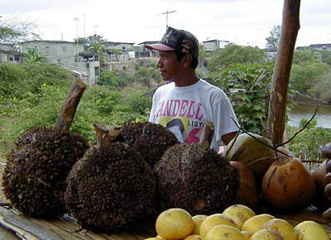 Ecuador, the smallest of South America's countries, owes its unique biodiversity to its geographical setting and climate; a hybrid area of Pacific Coast beaches, sweltering rainforests, the UNESCO-protected Galapagos Islands and the snow-capped volcanoes of the Andean highlands. Sadly pollution, deforestation and global warming have threatened one of the World's most diverse ecosystems.
Ecuador, the smallest of South America's countries, owes its unique biodiversity to its geographical setting and climate; a hybrid area of Pacific Coast beaches, sweltering rainforests, the UNESCO-protected Galapagos Islands and the snow-capped volcanoes of the Andean highlands. Sadly pollution, deforestation and global warming have threatened one of the World's most diverse ecosystems.
Fortunately, the collection and harvesting of tagua nut, a rainforest nut known as vegetable ivory for its likeness to animal ivory, has emerged as a viable alternative for villagers who once depended on logging, wildlife trafficking and other unsustainable activities to earn a living. Tagua's smooth, hard texture offers artisans an ideal medium for carving jewelry, boxes and other figurines, and helps keep animal ivory on real animals where it belongs. Harvesting tagua also encourages locals to depend on the rainforest for their livelihoods, which motivates them to better protect and conserve this part of the Amazon, thereby saving thousands of acres of trees, plants and wildlife habitat. With the near extinction of animal ivory, tagua has become a highly valued commodity by artisans and consumers alike.
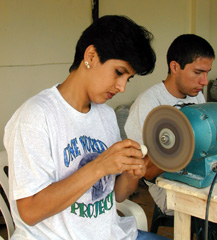
Tagua nuts are actually seeds that grow in pods called cabezas from the tagua nut palm tree. Villagers are paid to collect the cabezas, which ripen and fall naturally onto the rainforest floor, and then harvest the seeds for artisans who will transform them into beautiful beads, jewelry, figurines and other works of art.
There are five steps involved in creating a tagua nut figurine: shaping, detailing, sanding, polishing and drying. Shaping is achieved using a circular sand paper with a very coarse grit. The piece is detailed with a Dremel tool and various bits and sanded with a fine sand paper. Next, the figurine is polished with a buffing cloth and a light polishing compound, and finally placed beneath paper or a towel to dry under a heat lamp for 24 hours. This is similar to incubating a chicken egg - not too hot, just nice and warm - and ensures the carvings won't crack later.
Tagua is colored in many ways:
1. Boiling. Artisans achieve rich yellows and browns by boiling; this process essentially burns the tagua. The length of boiling time determines the color.
2. Inlay. Artisans inlay their carvings with the brown skin of the tagua nut, which is first ground into a fine powder, then mixed with super glue and reapplied to the carving's recesses.
3. Fermentation. Fermented tagua is yellow to chocolate in color and produced when unpeeled tagua is left in the rain to ferment. This rots the shell and discolors the tagua nut inside.
4. Burning. Sometimes burning, particularly in jewelry, is accomplished with a wood burning tool. This turns the tagua black and allows the artisan to etch designs into the tagua.
5. Dying. Many of our tagua nut beads are dyed. The tagua is placed in boiling water with the dye and the nut soaks in the color. Many of these colors are achieved through the use of natural plant-based dyes.
Some artisans also paint or stain their pieces, but we feel these techniques detract from the overall piece by covering up the tagua's natural beauty. As such, all of our colors are achieved using one of the methods mentioned above. It's also important to note that, like animal ivory, most tagua will darken or antique over time, although the rate of discoloration seems related to the nut's moisture content. For example, tagua carvings that haven't been through the final drying phase yellow more rapidly than completely dried pieces, while exposure to sunlight speeds up discoloration.
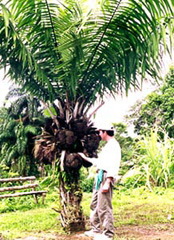 Naya Nayon, an Ecuador-based NGO, counters poverty and deforestation by creating new jobs that depend on conservation and responsible forest management. To accomplish this goal, the company works with 23 local artisans to create figurines, jewelry and ornaments from tagua nuts. These nuts grow year-round in Ecuador and can be harvested without detriment to the rainforest. Naya Nayon gives its artisans all the training, tools and materials they need to work from home, and then manages work distribution from the organizations main office to make sure orders are fairly distributed.
Naya Nayon, an Ecuador-based NGO, counters poverty and deforestation by creating new jobs that depend on conservation and responsible forest management. To accomplish this goal, the company works with 23 local artisans to create figurines, jewelry and ornaments from tagua nuts. These nuts grow year-round in Ecuador and can be harvested without detriment to the rainforest. Naya Nayon gives its artisans all the training, tools and materials they need to work from home, and then manages work distribution from the organizations main office to make sure orders are fairly distributed.
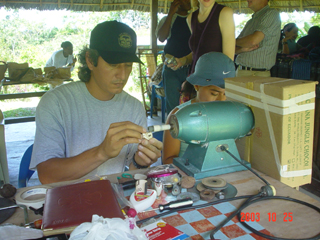 Naya Nayon's artisans work in home-based workshops throughout the country. Within each workshop, which is usually attached to an artisan's home, one artisan serves as the leader/manager and hires family members and friends to help produce products. New artisans begin by sanding and polishing figurines made by the more experienced artisans, and then gradually progress into the more complicated aspects of the craft, such as detailing, burning/coloring, and finally shaping the crude form of the nut. As demand and production increases, more artisans are invited to join the workshop. When the workshop grows to about 8 people, an experienced worker leaves to form a new workshop and train new artisans, and the cycle of learning continues.
Naya Nayon's artisans work in home-based workshops throughout the country. Within each workshop, which is usually attached to an artisan's home, one artisan serves as the leader/manager and hires family members and friends to help produce products. New artisans begin by sanding and polishing figurines made by the more experienced artisans, and then gradually progress into the more complicated aspects of the craft, such as detailing, burning/coloring, and finally shaping the crude form of the nut. As demand and production increases, more artisans are invited to join the workshop. When the workshop grows to about 8 people, an experienced worker leaves to form a new workshop and train new artisans, and the cycle of learning continues.
Despite their humble backgrounds, many of Naya Nayon's artisans are highly educated with university degrees in engineering, law, business, and medicine. Unfortunately, Ecuador's shaky economy means jobs are scarce, even for highly-qualified professionals. Thankfully, Tagua nut carving has emerged as a sustainable alternative and is often the primary source of income for an artisan's family.
About the Artisans
About the Artisans
Ceramica Quinua, an artisan cooperative known for its social and environmental responsibility, offers steady work to six workshops and 36 families in Ayachucho, Peru. Ceramica Quinua is dedicated to decreasing the use of firewood to reduce deforestation, and as such, works primarily with clay, which is extracted from the land in a controlled manner to avoid erosion.
The artisans shape and fire their pieces in home-based workshops during their nine-hour workday. Children often sit in on the workshops during their free time in so they may learn the trade that's been passed from ancestor to ancestor. The organization also takes pride in offering health care for its craftsmen, and for sharing its environmental knowledge and conservation techniques with students at public schools.
The Quinua district is characterized by the eucalyptus and alder-scented atmosphere of its mountain and forest landscapes. The name Quinua is derived from the Qenwal plant, said to be comparable in beauty only to the Quinuin women. The unique flora and fauna that inhabit the territory are fast becoming a major tourist attraction. Unfortunately, deforestation and pollution from paint chemicals are threatening their existence.
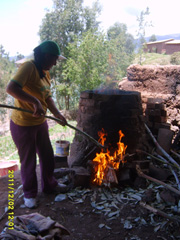
Materials
Materials
Dimensions
Dimensions
Care information
Care information




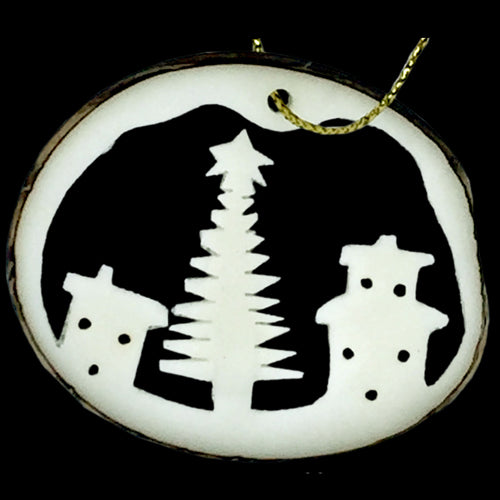
Subscribe to our emails
Subscribe to our mailing list for insider news, product launches, and more.





